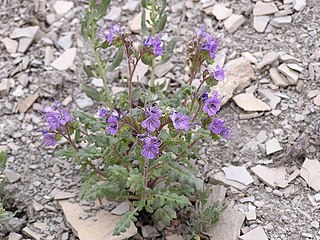
Phacelia campanularia is a species of flowering plant in the borage family, Boraginaceae, known by the common names desertbells, desert bluebells, California-bluebell, desert scorpionweed, and desert Canterbury bells. Its true native range is within the borders of California, in the Mojave and Sonoran Deserts, but it is commonly cultivated as an ornamental plant and it can be found growing elsewhere as an introduced species.

Bartlettia is a monotypic genus of flowering plants in the aster family, Asteraceae. It contains the single species Bartlettia scaposa, known commonly as the Bartlett daisy. It is native to Mexico and to New Mexico and Texas in the United States.
Phacelia affinis is a species of flowering plant in the borage family, Boraginaceae, known by the common names limestone phacelia and purple-bell scorpionweed. It is native to the southwestern United States and Baja California and Sonora in Mexico. It can be found in scrub, woodland, forest, and other habitat.

Howellanthus is a monotypic genus of flowering plants in the borage family containing the single species Howellanthus dalesianus, commonly known as Scott Mountain phacelia or Howell's phacelia. Until 2010 the plant was known as Phacelia dalesiana. It is endemic to the southern Klamath Mountains of northern California, including the Scott Mountains for which it is named. It grows in mountain forests and meadows often on serpentine soils.

Phacelia distans is a species of flowering plant in the borage family, Boraginaceae, known by the common names distant phacelia and distant scorpionweed. It is native to the southwestern United States and northwestern Mexico, where it grows in many types of habitat, including forest, woodland, chaparral, grassland, and meadows.

Phacelia insularis, the coast phacelia is a rare species of phacelia. It is endemic to California, where it has a disjunct distribution.

Phacelia ivesiana is a species of flowering plant in the borage family, Boraginaceae. Its common names include Ives' phacelia and Ives' scorpionweed. It is divided into varieties that have been called sticky scorpionweed. It is native to the western United States.

Phacelia linearis, the linear-leaved phacelia or threadleaf phacelia, is a species of phacelia.

Phacelia mutabilis is a species of flowering plant in the borage family known by the common name changeable phacelia. It is native to the western United States and Baja California, where it can be found in mountains and foothills, in forested and open habitat types, and deserts.

Phacelia neglecta is a species of flowering plant in the borage family, Boraginaceae. Its common names include alkali phacelia and neglected scorpionweed. It is native to the deserts of the southwestern United States in Nevada, Arizona, and southeastern California, where it grows in varied desert habitat, including areas with alkali soils. It is likely that its distribution extends into Baja California.

Phacelia nemoralis is a species of flowering plant in the borage family known by the common name shade phacelia. It is native to the west coast of the United States from Washington to central California, where it grows in moist, usually forested areas along the coastline and in the coastal mountain ranges.

Phacelia pedicellata is a species of flowering plant in the borage family, Boraginaceae. Its common names include specter phacelia and pedicellate phacelia. It is native to the southwestern United States and Baja California, where it can be found in several types of habitat, including creosote bush scrub and Joshua tree woodland.

Phacelia pringlei is a species of flowering plant in the borage family known by the common name Pringle's phacelia. It is endemic to far northern California, where it is known only from the southern Klamath Mountains. It grows in coniferous forest and open mountain slopes.

Phacelia quickii is a species of phacelia known by the common name Quick's phacelia.

Phacelia viscida is a species of phacelia known by the common names sticky phacelia and tacky phacelia.

Phacelia argillacea is a rare species of flowering plant in the borage family known by the common names clay phacelia and Atwood's phacelia. It is endemic to Utah in the United States, where it is known only from one canyon in Utah County. It is "one of Utah's most endangered species"; it is "one of the nation's rarest plants" and is federally listed as an endangered species of the United States.

Ipomopsis polyantha is a rare species of flowering plant in the phlox family known by the common names Pagosa ipomopsis, Pagosa skyrocket and Archuleta County standing-cypress. It is endemic to Colorado in the United States, where it occurs only in the vicinity of Pagosa Springs in Archuleta County. It is threatened by the loss of its habitat to residential and commercial development. It was federally listed as an endangered species in 2011.

Mentzelia mollis is a species of flowering plant in the Loasaceae known by the common names soft blazingstar, smooth blazingstar, and smooth stickleaf. It is native to the western United States, where it occurs in Idaho, Oregon, and Nevada.
Senecio ertterae is a species of flowering plant in the aster family known by the common name Ertter's ragwort. It is endemic to Oregon, United States.

Phacelia dubia is an annual forb native to the eastern United States, that produces cream colored or light blue flowers in early spring.

















